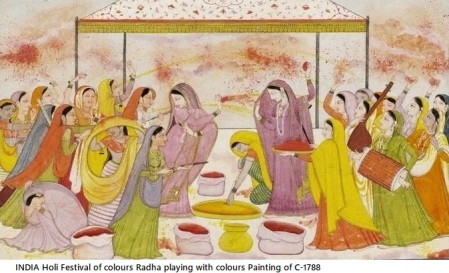Post -by Gautam Shah
.

Dyes and pigments are colourants. These substances impart a colour to a material. Pigments are nearly insoluble materials, resulting in a suspension, whereas the Dyes dissolve during application, losing their particulate structure, resulting in a solution. Often a pigment is made by attaching a dye molecule to an insoluble particle. The difference between the two, can be said due to the physical characteristics rather than chemical composition.

‘Dye molecules are comparatively smaller, so if each is presumed to be of pinhead size, relative size of a pigment particle would be of a football’.

Traditionally pigments are considered to be more light-fast than dyes. Light destroys coloured objects by breaking open electronic bonding within the colourant molecule. Light fastness or permanence and stability are desirable properties of colourants. Lower Dyes are very much vulnerable. Pigments that are not permanent are called fugitive, as they over-time fade out.

Pigments change the colour of reflected or transmitted lights as a result of wavelength-selective absorption, wavelengths or parts of the spectrum are reflected or scattered. Pure pigments allow very little white light to escape, producing a highly saturated colour. However, a dye can only absorb light, and not reflect or scatter it. Pigments, can only subtract wavelengths from the source light, never add new ones, unlike the fluorescent or phosphorescent substances.

Organic pigments have carbon compounds. Natural ones were of animal and vegetable origins. Synthetic organic pigments include, alizarin, azo-pigments (yellow, orange red), phthalocyanine (variants of blue, green colour) and quinacridone (red-violet).
Inorganic pigments (of mineral origins) are metal compounds compared to organic pigments. Examples of Natural inorganic pigments: Oxides, umber, ochres and sienna. Pigments produced synthetically often have the same names. Other Synthetic inorganic pigments include, cadmium yellow/orange/red, cobalt blue and titanium white.

Coatings are clear, dyed or pigmented. Clear-coatings are essentially, transparent to translucent in effect. Though, ‘water-white’ Clear Coatings are without any type of colourants. However, some tinted clear coatings or stainers include soluble colourants or dyes and often very minute quantity of non-soluble colourants or pigments. Dyes, are colourants soluble in water, organic solvents or oils. Clear coatings are used for where a very high level of transparency is required such as for the production of coloured metal foils and films, internal protective layer for cold-drink tins, coatings over paper, for flamboyant finishes in the paint industry and for wood stains (for floorboards and furniture). Dyes are also used for imparting colour to thermoplastics.


Pigmented coatings are mainly opaque. The opacity of the film, in a few cases, is inherent in the molecular lattice of the film forming medium, but mostly is imparted by additives (pigments and extenders) of crystalline nature. Pigments, natural or synthetics have a fine particulate matter, but these are in agglomerated state and require dispersion. Pigments are ground using ball-mill, roll-mill and attritor like equipments. Dispersion increases the spread of pigment or its covering or colouring capacity. Hiding capacity of pigment also depends on the particle size, shape and distribution, concentration, and also on the film thickness and clarity of the film forming substance. Pigments due to their particle size, shape and structure have greater capacity to reflect, refract and diffract the incident light, compared to extenders on volume basis.

Additives with optical properties form the major and the quantitatively substantial part of a coating system, which otherwise consists of liquids or liquefiable film forming substances. Extenders, are low refractivity materials. Extenders have refractive index equal or lower than the pigments. Extenders provide bulk to the film, condition the viscosity, help even distribution of pigments, improve the brush-ability and define the gloss level and texture.

Extenders are mostly inorganic compounds like oxides, hydroxides, carbonates, silicates and sulphate, of metals like barium, calcium, aluminium and magnesium. Commercial extenders are asbestine, barytes, blanc fixe, china clay, diatomaceous silica, dolomite, mica, precipitated calcium carbonate, talc and whiting or chalks. Pigment and extender particles, both are held together by strong forces of attraction and are often enveloped by air moisture and other affinitive substances.

.